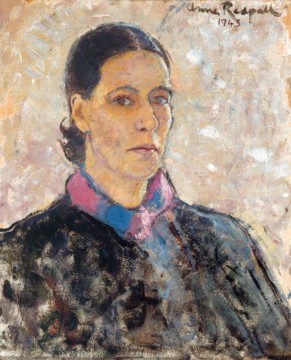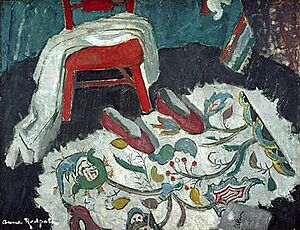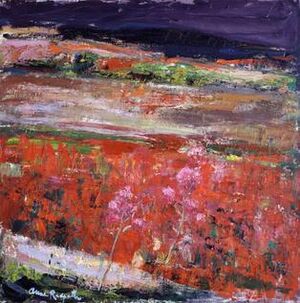Anne Redpath facts for kids
Quick facts for kids
Anne Redpath
|
|
|---|---|

Self-portrait
|
|
| Born | 1895 Galashiels, Scotland
|
| Died | 1965 (aged 69–70) Edinburgh, Scotland
|
| Education | Edinburgh College of Art |
| Known for | Painting |
| Movement | The Edinburgh School |
| Spouse(s) |
James Michie
(m. 1920) |
Anne Redpath (1895–1965) was a famous Scottish artist. She was known for her bright and lively paintings of everyday objects, like things you might find in a home. These paintings are called still lifes.
Life Story of Anne Redpath

Anne Redpath's father designed tweed fabric in Scotland. She felt that her way of using colors in paintings was like his way of using colors in tweed. She once said, "I do with a spot of red or yellow in a harmony of grey, what my father did in his tweed."
When Anne was about six, her family moved from Galashiels to Hawick. After high school, she went to the Edinburgh College of Art in 1913. After finishing her studies, she won a special scholarship. This allowed her to travel around Europe in 1919. She visited cities like Bruges, Paris, Florence, and Siena.
In 1920, she married James Michie, who was an architect. They moved to France, where her first two sons were born. Her oldest son, Alastair Michie, also became a painter and sculptor. In 1924, they moved to the South of France. Their third son, David Michie, who is also an artist, was born there in 1928.
In 1934, Anne Redpath came back to Hawick, Scotland. Soon, her paintings were shown in exhibitions in Edinburgh. She became the president of the Scottish Society of Women Artists from 1944 to 1947. In 1947, she was accepted into the Royal Scottish Academy. This is a group of important artists. In 1952, she became the first woman painter to be a full member, called an Academician. (A sculptor named Phyllis Bone was the first woman Academician overall in 1944).
In 1955, Anne Redpath received an award called the OBE. This was for her work as an artist and for being on the board of the Edinburgh College of Art.
Once her children were grown up, she moved to Edinburgh in the late 1940s. She was very active in the art scene there. In the 1950s and early 1960s, she traveled more in Europe. She painted in places like Spain, the Canary Islands, Corsica, Brittany, and Venice.
There is a special plaque on the house where she lived in Edinburgh, at 7 London Street.
Anne Redpath's Painting Style


Anne Redpath is most famous for her still life paintings. In these, she took everyday things like a chair or a cup and made them into interesting designs. She often used patterned fabrics, like a printed tablecloth or a spotted scarf, to add more patterns to her art. The Indian Rug is a great example of this style.
You can see the influence of the famous artist Henri Matisse in her bold and flat-looking interior scenes. Art experts also notice that her paintings sometimes show tabletops tilted in a way that suits the design, not how they would look in real life. This was influenced by medieval paintings from Siena that she saw on her first trip to Europe. It was also when she first saw rich Catholic art, which was new to her as she grew up in a Scottish Protestant family. This religious art became a theme in some of her later works.
Anne Redpath and some other artists of her time are sometimes called The Edinburgh School. They are seen as following in the footsteps of the Scottish Colourists, who were known for their bright colors. For example, Redpath's painting The Orange Chair shows this link to the Colourists.
While she lived in France (1920–1933), Anne Redpath didn't paint as much because of her family duties. But she still created enough art for exhibitions in 1921 and 1928. She also decorated furniture with bright flowers and birds. Later, she painted many pictures of flowers, both in vases and growing wild. The Poppy Field is one such example. She was greatly influenced by artists like Henri Matisse and Pierre Bonnard.
When she returned to Scotland in 1934, she began sketching the countryside around Hawick. She painted landscapes that looked a bit softer than her other works, like Frosty Morning, Trow Mill (1936). By the early 1940s, paintings like The Indian Rug showed her developing a more free and unique style. Other paintings in this style include The Mantelpiece and Still Life with Table.
Around 1943, she painted a self-portrait (a picture of herself). A collector named Ruth Borchard asked her for it. Redpath sent the painting in 1964, making sure to mark the date as 1943. She didn't want people to think she had painted herself looking 20 years younger! A friend who traveled with Redpath in 1951 said she looked like "Queen Victoria" with her black hair parted in the middle. But she always wore colorful clothes! Her serious self-portrait also has touches of color, just like her father added bright threads to his tweed.
Window in Menton, painted in 1948, was one of Redpath's favorites. It has a rich texture and familiar items like flowers, a chair, and patterned wallpaper. In this painting, a woman sits looking out a large open window. Outside, you can see a hillside covered with houses and trees.
As she traveled later in her life, Redpath painted more hillsides, such as Les Tourettes (1962). But she was still often interested in painting indoor scenes. Her Courtyard in Venice (1964) is another painting that shows a view from inside looking out.
Some of her later paintings show religious influences. These include paintings of altars, like The Chapel of St Jean - Treboul (1954) and Venetian Altar. Many art experts think these later works are even more impressive than her earlier paintings from the 1940s.
Exhibitions
The Portland Gallery held a large exhibition of Anne Redpath's paintings in July 2008.
See also
 In Spanish: Anne Redpath para niños
In Spanish: Anne Redpath para niños

